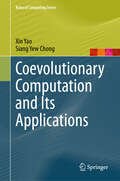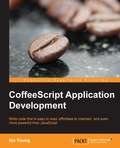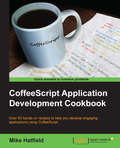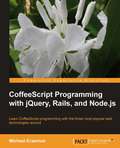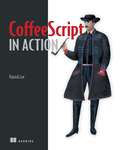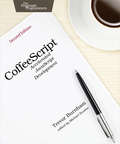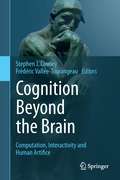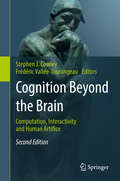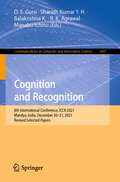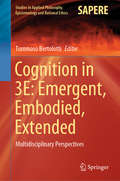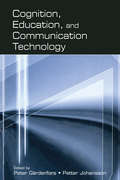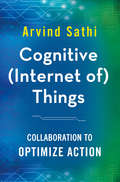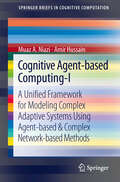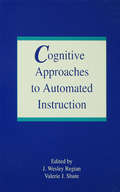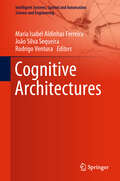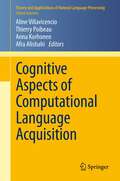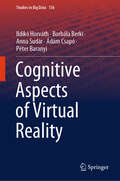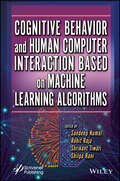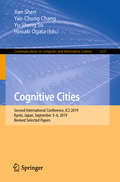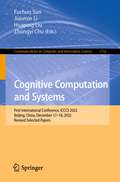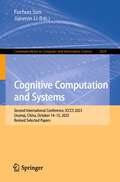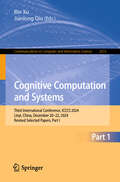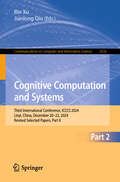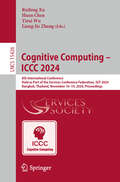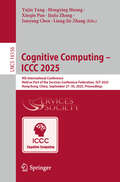- Table View
- List View
Coevolutionary Computation and Its Applications (Natural Computing Series)
by Xin Yao Siang Yew ChongThis book introduces the fundamentals of Coevolutionary Computation and presents new methodologies that are developed and then employed for modern real-world problem-solving in various applications across different domains. It is structured in three main parts to support the anticipated general and frequent usage of the book. In particular, the reader is able to obtain a quick and general introduction on the principles of coevolution in Part I, and then go over in detail the specifics how coevolutionary principles are exploited and applied to solve specific problems in the relevant chapters of Parts II and III. In this manner, Part I will introduce the fundamentals in Coevolutionary Computation with no assumption made on familiarity with Evolutionary Computation literature. These fundamentals include key concepts and operational principles of both evolutionary and coevolutionary processes that are modelled as iterative algorithms and systems implementable in computing machines. Parts II and III contain various applications of coevolution to problems that are framed in the context of optimization and learning, respectively. Detailed procedural implementations are provided for those methodologies as well as analysis that highlight the improvements they bring about over conventional techniques.
CoffeeScript Application Development
by Ian YoungCoffeeScript Application Development is a practical, hands-on guide with step-by-step instructions. Follow the smooth and easy tutorial approach, covering examples that build in complexity. By the final chapter you'll be wondering why you didn't try CoffeeScript sooner.If you are a JavaScript developer who wants to save time and add power to your code, then this is the book that will help you do it. With minimal fuss you will learn a whole new language which will reduce your application development time from weeks to days.
CoffeeScript Application Development Cookbook
by Mike HatfieldIf you are interested in developing modern applications, this book will help you leverage the vast JavaScript ecosystem while using an elegant language, helping you avoid the shortcomings of JavaScript.
CoffeeScript Programming with jQuery, Rails, and Node.js
by Michael ErasmusIt's a quick guide for programming CoffeeScript and then diving into programming with Rails, jQuery, and Node.js. This book is for web developers who would like to learn programming with CoffeScript. It is also for developers who have some experience in JavaScript and are curious to learn CoffeScript and build applications with it.
CoffeeScript in Action
by Patrick LeeSummaryCoffeeScript in Action is a tutorial that teaches you how, where, and why to use CoffeeScript. It begins by quickly exposing you to CoffeeScript's new, but instantly-familiar syntax. Then, you'll explore programming challenges that illustrate CoffeeScript's unique advantages. Language junkies will especially appreciate how this book takes idioms from other programming languages and shows you how CoffeeScript makes them available in JavaScript.Purchase of the print book includes a free eBook in PDF, Kindle, and ePub formats from Manning Publications.About the BookJavaScript runs (almost) everywhere but it can be quirky and awkward. Its cousin CoffeeScript is easier to comprehend and compose. An expressive language, not unlike Ruby or Python, it compiles into standard JavaScript without modification and is a great choice for complex web applications. It runs in any JavaScript-enabled environment and is easy to use with Node.js and Rails.CoffeeScript in Action teaches you how, where, and why to use CoffeeScript. It immerses you in CoffeeScript's comfortable syntax before diving into the concepts and techniques you need in order to write elegant CoffeeScript programs. Throughout, you'll explore programming challenges that illustrate CoffeeScript's unique advantages. For language junkies, the book explains how CoffeeScript brings idioms from other languages into JavaScript.What's InsideCoffeeScript's syntax and structureWeb application patterns and best practicesPrototype-based OOPFunctional programmingAsynchronous programming techniquesBuilds and testingReaders need a basic grasp of web development and how JavaScript works. No prior exposure to CoffeeScript is required.About the AuthorPatrick Lee is a developer, designer, and software consultant, working with design startup Canva in Sydney, Australia.Table of ContentsPART 1 FOUNDATIONSThe road to CoffeeScriptSimplified syntaxFirst-class functionsDynamic objectsPART 2 COMPOSITIONComposing objectsComposing functionsStyle and semanticsMetaprogrammingComposing the asynchronousPART 3 APPLICATIONSDriving with testsIn the browserModules and buildsECMAScript and the future of CoffeeScript
CoffeeScript: Accelerated JavaScript Development
by Trevor BurnhamOver the last five years, CoffeeScript has taken the web development world by storm. With the humble motto "It's just JavaScript," CoffeeScript provides all the power of the JavaScript language in a friendly and elegant package. This extensively revised and updated new edition includes an all-new project to demonstrate CoffeeScript in action, both in the browser and on a Node.js server. There's no faster way to learn to write a modern web application.This new edition has been extensively revised and updated to reflect the current state and features of CoffeeScript. Every chapter has been revised and refactored, and new sections and a new chapter on testing have been added. If you already know JavaScript, this book will make your transition to CoffeeScript easy. If you're new to JavaScript, it's a great place to start.New in this edition: Automating setup with the Grunt task runner Using CoffeeScript classes with the Backbone framework Using CoffeeScript's simple callback syntax to interact with the Express framework A new chapter on client-side and server-side testing with Intern* A new project that gives you hands-on experience with browser-side and server-side CoffeeScriptCoffeeScript is every bit as portable and effective as JavaScript. It aids development by adding a bevy of features, such as classes, splats, list comprehensions, and destructuring. These features make it easier to write clear, readable code, and by learning how these features work, you'll deepen your understand of JavaScript as well. This book is your complete guide to writing better JavaScript code, faster.
Cognition Beyond the Brain: Computation, Interactivity and Human Artifice
by Stephen J. Cowley Frédéric Vallée-TourangeauCognition Beyond the Brain challenges neurocentrism by advocating a systemic view of cognition based on investigating how action shapes the experience of thinking. The systemic view steers between extended functionalism and enactivism by stressing how living beings connect bodies, technologies, language and culture. Since human thinking depends on a cultural ecology, people connect biologically-based powers with extended systems and, by so doing, they constitute cognitive systems that reach across the skin. Biological interpretation exploits extended functional systems. Illustrating distributed cognition, one set of chapters focus on computer mediated trust, work at a construction site, judgement aggregation and crime scene investigation. Turning to how bodies manufacture skills, the remaining chapters focus on interactivity or sense-saturated coordination. The feeling of doing is crucial to solving maths problems, learning about X rays, finding an invoice number, or launching a warhead in a film. People both participate in extended systems and exert individual responsibility. Brains manufacture a now to which selves are anchored: people can act automatically or, at times, vary habits and choose to author actions. In ontogenesis, a systemic view permits rationality to be seen as gaining mastery over world-side resources. Much evidence and argument thus speaks for reconnecting the study of computation, interactivity and human artifice. Taken together, this can drive a networks revolution that gives due cognitive importance to the perceivable world that lies beyond the brain. Cognition Beyond the Brain is a valuable reference for researchers, practitioners and graduate students within the fields of Computer Science, Psychology, Linguistics and Cognitive Science.
Cognition Beyond the Brain: Computation, Interactivity and Human Artifice
by Stephen J. Cowley Frédéric Vallée-TourangeauThis book challenges neurocentrism by advocating a systemic view of cognition based on investigating how action shapes the experience of thinking, placing interactivity at its heart. This systemic viewpoint makes three main claims. First, that many elaborate cognitive skills like language, problem solving and human-computer interaction (HCI) are based in sense-saturated coordination or interactivity. Second, interactivity produces a tightly woven scaffold of resources, some internal to the agent and others external, that elevates and transforms thinking. Third, human agents entwine brains, bodies and their surroundings as they manage multi-scalar dynamics. This new edition continues to demonstrate how a systemic perspective casts a productive light on thinking in applied domains such as crime scene analysis, the use of information technology in construction, and computer-meditated trusts and presents new studies on the cognitive ecology of the web, multi-scalar temporal and organisational cognition and the importance of interactive material engagement in digital architecture. Authors use various scales of the systemic viewpoint to illustrate how bodies and artefacts shape thinking, but in all cases the experience of materiality is meshed with activity that involves the world beyond the body. Cognition Beyond the Brain is a valuable reference for researchers, practitioners and graduate students within the fields of Computer Science, Psychology, Linguistics and Cognitive Sciences.
Cognition and Recognition: 8th International Conference, ICCR 2021, Mandya, India, December 30–31, 2021, Revised Selected Papers (Communications in Computer and Information Science #1697)
by D. S. Guru R. K. Agrawal Sharath Kumar Y. H. Balakrishna K. Manabu IchinoThis volume constitutes the refereed proceedings of the Eighth International Conference on Cognition and Recognition, ICCR 2021, held in Mandya, India, in December 2021.The 24 full papers and 9 short papers presented were carefully reviewed and selected from 150 submissions. The ICCR conference aims to bring together leading academic Scientists, Researchers and Research scholars to exchange and share their experiences and research results on all aspects of Computer Vision, Image Processing Machine Learning and Deep Learning Technologies.
Cognition in 3E: Multidisciplinary Perspectives (Studies in Applied Philosophy, Epistemology and Rational Ethics #56)
by Tommaso BertolottiThis book originated at a workshop by the same name held in May 2018 at the University of Pavia. The aim was to encourage a cross-disciplinary discussion on the limits of cognition. When venturing into cognitive science, notwithstanding the approach, one of the first riddles to be solved is the definition of cognition. Any definition immediately sparks the ascription debate: who/what cognizes? Definitions may appear either too loose, or too demanding. Are bacteria included? What about plants? Is it a human prerogative? We engage in the quest for artificial intelligence, but is artificial cognition already the case? And if it was a human prerogative, are we doing it all the time? Is cognition a process, or the sum of countless sub processes? Is it in the brain, or also in the body? Or does it go beyond the body? Where does it start? Where does it end? We tried answering these questions each from our own perspectives, as philosophers, ethnographers, psychologists and rhetoricians, handing each other our peculiar insight.
Cognition, Education, and Communication Technology
by Peter Gärdenfors Petter JohanssonCognition, Education, and Communication Technology presents some of the recent theoretical developments in the cognitive and educational sciences and implications for the use of information and communication technology (ICT) in the organization of school and university education. Internationally renowned researchers present theoretical perspectives with proposals for and evaluations of educational practices. Each chapter discusses different aspects of the use of ICT in education, including:*the role of perceptual processes in learning;*external cognition as support for interactive learning;*the role of meta-cognition;*simulation learning environments as cognitive tools;*the role of science controversy for knowledge integration;*the use of ICT in the development of educators; and*the role of narratives in education.ICT has great potential for revolutionizing education. Large investments of resources are being made, often without a strong understanding of how ICT will or should be implemented. The expectation is that students will show immediate improvements in terms of their motivation to learn and their learning achievements, but reality is different. Progress of ICT in education requires more than just computers in the classroom. It demands an understanding of the complex processes contributing to human learning and how they interact with new technologies. This text provides theoretical perspectives on the learning processes that can be used as a foundation for constructing pedagogically valuable tools based on ICT.The combination of results--from cognitive science and pedagogy, with more practically oriented suggestions for how ICT can be used in various forms of education--makes this book suitable for researchers and students in the cognitive and educational sciences, as well as for practitioners and planners of education.
Cognitive (Internet of) Things: Collaboration to Optimize Action
by Arvind SathiThis book explores cognitive behavior among Internet of Things. Using a series of current and futuristic examples - appliances, personal assistants, robots, driverless cars, customer care, engineering, monetization, and many more - the book covers use cases, technology and communication aspects of how machines will support individuals and organizations. This book examines the Cognitive Things covering a number of important questions: * What are Cognitive Things? * What applications can be driven from Cognitive Things - today and tomorrow? * How will these Cognitive Things collaborate with each and other, with individuals and with organizations? * What is the cognitive era? How is it different from the automation era? * How will the Cognitive Things support or accelerate human problem solving? * Which technical components make up cognitive behavior? * How does it redistribute the work-load between humans and machines? * What types of data can be collected from them and shared with external organizations? * How do they recognize and authenticate authorized users? How is the data safeguarded from potential theft? Who owns the data and how are the data ownership rights enforced? Overall, Sathi explores ways in which Cognitive Things bring value to individuals as well as organizations and how to integrate the use of the devices into changing organizational structures. Case studies are used throughout to illustrate how innovators are already benefiting from the initial explosion of devices and data. Business executives, operational managers, and IT professionals will understand the fundamental changes required to fully benefit from cognitive technologies and how to utilize them for their own success.
Cognitive Agent-based Computing-I: A Unified Framework for Modeling Complex Adaptive Systems using Agent-based & Complex Network-based Methods (SpringerBriefs in Cognitive Computation #1)
by Amir Hussain Muaz A NiaziComplex Systems are made up of numerous interacting sub-components. Non-linear interactions of these components or agents give rise to emergent behavior observable at the global scale. Agent-based modeling and simulation is a proven paradigm which has previously been used for effective computational modeling of complex systems in various domains. Because of its popular use across different scientific domains, research in agent-based modeling has primarily been vertical in nature. The goal of this manuscript is to provide a single hands-on guide to developing cognitive agent-based models for the exploration of emergence across various types of complex systems. We present practical ideas and examples for researchers and practitioners for the building of agent-based models using a horizontal approach - applications are demonstrated in a number of exciting domains as diverse as wireless sensors networks, peer-to-peer networks, complex social systems, research networks, epidemiological HIV
Cognitive Approaches To Automated Instruction
by Valerie J. Shute J. Wesley RegianUseful to researchers as well as practitioners looking for guidance on designing automated instruction systems, this book provides a snapshot of the state-of-the-art in this research area. In so doing, it focuses on the two critical problems: first, diagnosis of the student's current level of understanding or performance; and second, selection of the appropriate intervention that will transition the student toward expert performance. Containing a comprehensive set of principled approaches to automated instruction, diagnosis, and remediation, it is the first volume on the topic to provide specific, detailed guidance on how to develop these systems. Leading researchers and practitioners represented in this book address the following questions in each chapter: * What is your approach to cognitive diagnosis for automated instruction? * What is the theoretical basis of your approach? * What data support the utility of the approach? * What is the range of applicability of your approach? * What knowledge engineering or task analysis methods are required to support your approach? Referring to automated instruction as instruction that is delivered on any microprocessor-based system, the contributors to -- and editors of -- this book believe that is it possible for automated instructional systems to be more effective than they currently are. Specifically, they argue that by using artificial intelligence programming techniques, it is possible for automated instructional systems to emulate the desirable properties of human tutors in one-on-one instruction.
Cognitive Architectures (Intelligent Systems, Control and Automation: Science and Engineering #94)
by Maria Isabel Aldinhas Ferreira João Silva Sequeira Rodrigo VenturaThis book provides an integrated framework for natural and artificial cognition by highlighting the fundamental role played by the cognitive architecture in the dialectics with the surrounding environment and consequently in the definition of a particular meaningful world.This book is also about embodied and non-embodied artificial systems, cognitive architectures that are human constructs, meant to be able to populate the human world, capable of identifying different life contexts and replicating human patterns of behavior capable of acting according to human values and conventions, systems that perform tasks in a human-like way. By identifying the essential phenomena at the core of all forms of cognition, the book addresses the topic of design of artificial cognitive architectures in the domains of robotics and artificial life. Moving from mere bio-inspired design methodology it aims to open a pathway to semiotically determined design.
Cognitive Aspects of Computational Language Acquisition (Theory and Applications of Natural Language Processing)
by Aline Villavicencio Anna Korhonen Thierry Poibeau Afra AlishahiQuestions related to language acquisition have been of interest for many centuries, as children seem to acquire a sophisticated capacity for processing language with apparent ease, in the face of ambiguity, noise and uncertainty. However, with recent advances in technology and cognitive-related research it is now possible to conduct large-scale computational investigations of these issues The book discusses some of the latest theoretical and practical developments in the areas involved, including computational models for language tasks, tools and resources that help to approximate the linguistic environment available to children during acquisition, and discussions of challenging aspects of language that children have to master. This is a much-needed collection that provides a cross-section of recent multidisciplinary research on the computational modeling of language acquisition. It is targeted at anyone interested in the relevance of computational techniques for understanding language acquisition. Readers of this book will be introduced to some of the latest approaches to these tasks including: * Models of acquisition of various types of linguistic information (from words to syntax and semantics) and their relevance to research on human language acquisition * Analysis of linguistic and contextual factors that influence acquisition * Resources and tools for investigating these tasks Each chapter is presented in a self-contained manner, providing a detailed description of the relevant aspects related to research on language acquisition, and includes illustrations and tables to complement these in-depth discussions. Though there are no formal prerequisites, some familiarity with the basic concepts of human and computational language acquisition is beneficial.
Cognitive Aspects of Virtual Reality (Studies in Big Data #156)
by Péter Baranyi Ildikó Horváth Borbála Berki Anna Sudár Ádám CsapóThis book outlines a range of user experiments, providing comprehensive evaluations that underline the rationale behind implementing collaborative 3D virtual offices in corporate settings and 3D classrooms in educational institutions. In this book, radically new scientific approaches are taken for studying user effectiveness in the realm of 3D graphical interfaces. The emergence of VR is seen in the book as a pivotal moment in the evolution of information technology, marking a shift from the era of DOS and Windows to immersive digital spaces. Through extensive research and experimentation, it is convincingly demonstrated that integrating 2D user interfaces, such as windows, images, and 2D widgets, into 3D digital environments significantly enhances user effectiveness in terms of online collaboration, memory, recall, and comprehension of complex workflows. Moreover, valuable advice and design principles are offered to guide the creation of such working 3D digital environments.
Cognitive Behavior and Human Computer Interaction Based on Machine Learning Algorithms
by Sandeep Kumar Rohit Raja Shilpa Rani Shrikant TiwariThe book focuses on the way that human beings and computers interact to ever increasing levels of both complexity and simplicity. Assuming very little knowledge, the book provides content on theory, cognition, design, evaluation, and user diversity. It aims to explain the underlying causes of the cognitive, social and organizational problems typically are devoted to descriptions of rehabilitation methods for specific cognitive processes. This book describes new algorithms for modeling accessible to cognitive scientists of all varieties. The book is inherently interdisciplinary, publishing original research in the fields of computing, engineering, artificial intelligence, psychology, linguistics, and social and system organization, as applied to the design, implementation, application, analysis, and evaluation of interactive systems. Machine learning research has been being carried out for a decade at international level in various applications. The new learning approach is mostly used in machine learning based cognitive applications. This will give direction for future research to scientists and researchers working in neuroscience, neuro-imaging, machine learning based brain mapping and modeling etc.
Cognitive Cities: Second International Conference, IC3 2019, Kyoto, Japan, September 3–6, 2019, Revised Selected Papers (Communications in Computer and Information Science #1227)
by Hiroaki Ogata Jian Shen Yao-Chung Chang Yu-Sheng SuThis book constitutes refereed proceeding of the Second International Cognitive Cities Conference, IC3 2019, held in Kyoto, Japan, in September 2019. The 37 full papers and 46 short papers were thoroughly reviewed and selected from 206 submissions. The papers are organized according to the topical sections on cognitive city for special needs; cognitive city theory, modeling and simulation; XR and educational innovations for cognitive city; educational technology and strategy in cognitive city; safety, security and privacy in cognitive city; artificial intelligence theory and technology related to cognitive city; Internet of Things for cognitive city; business application and management for cognitive city; big data for cognitive city; engineering technology and applied science for cognitive city; maker, CT and STEAM education for cognitive city.
Cognitive Computation and Systems: First International Conference, ICCCS 2022, Beijing, China, December 17–18, 2022, Revised Selected Papers (Communications in Computer and Information Science #1732)
by Huaping Liu Fuchun Sun Jianmin Li Zhongyi ChuThis volume constitutes selected papers presented during the First International Conference on Cognitive Computation and Systems, ICCCS 2022, held in Beijing, China, in October 2022.The 31 papers were thoroughly reviewed and selected from the 75 submissions. The papers are organized in topical sections on computer vision; decision making and cognitive computation; robot and autonomous vehicle.
Cognitive Computation and Systems: Second International Conference, ICCCS 2023, Urumqi, China, October 14–15, 2023, Revised Selected Papers (Communications in Computer and Information Science #2029)
by Fuchun Sun Jianmin LiThis book constitutes the refereed proceedings of the Second International Conference on Cognitive Computation and Systems, ICCCS 2023, held in Urumqi, China, October 14–15, 2023.The 26 full papers included in the book were carefully reviewed and selected from 68 submissions. ICCCS aims to bring together experts from different expertise areas to discuss the state-of-the-art in cognitive computing and intelligent systems, and to present new research results and perspectives on future development. They were organized in topical sections as follows: Perception and learning and decision making and systems.
Cognitive Computation and Systems: Third International Conference, ICCCS 2024, Linyi, China, December 20–22, 2024, Revised Selected Papers, Part I (Communications in Computer and Information Science #2515)
by Bin Xu Jianlong QiuThis book constitutes the refereed proceedings of the Third International Conference on Cognitive Computation and Systems, ICCCS 2024, held in Linyi, China, December 20–22, 2024. The 54 revised full papers presented in these proceedings were carefully reviewed and selected from 155 submissions. The papers are organized in the following topical sections: Part I: Cognitive computing and information processing; Intelligent cooperative control; and Learning and systems. Part II: Cognitive computing and information processing; Intelligent cooperative control; and Learning and systems.
Cognitive Computation and Systems: Third International Conference, ICCCS 2024, Linyi, China, December 20–22, 2024, Revised Selected Papers, Part II (Communications in Computer and Information Science #2516)
by Bin Xu Jianlong QiuThis book constitutes the refereed proceedings of the Third International Conference on Cognitive Computation and Systems, ICCCS 2024, held in Linyi, China, December 20–22, 2024. The 54 revised full papers presented in these proceedings were carefully reviewed and selected from 155 submissions. The papers are organized in the following topical sections: Part I: Cognitive computing and information processing; Intelligent cooperative control; and Learning and systems. Part II: Cognitive computing and information processing; Intelligent cooperative control; and Learning and systems.
Cognitive Computing - ICCC 2024: 8th International Conference, Held as Part of the Services Conference Federation, SCF 2024, Bangkok, Thailand, November 16–19, 2024, Proceedings (Lecture Notes in Computer Science #15426)
by Liang-Jie Zhang Ruifeng Xu Huan Chen Yirui WuThis book constitutes the refereed proceedings of the 8th International Conference on Cognitive Computing, ICCC 2024, Held as Part of the Services Conference Federation, SCF 2024, held in Bangkok, Thailand, during November 16–19, 2024. The 6 full papers and 2 short papers included in this book were carefully reviewed and selected from 10 submissions. They were organized in topical sections as follows: research track; application track; and short paper track.
Cognitive Computing - ICCC 2025: 9th International Conference, Held as Part of the Services Conference Federation, SCF 2025, Hong Kong, China, September 27–30, 2025, Proceedings (Lecture Notes in Computer Science #16156)
by Mengxing Huang Liang-Jie Zhang Yujiu Yang Xiuqin Pan Jiajia Zhang Junyang ChenThis book constitutes the refereed proceedings of the 9th International Conference on Cognitive Computing, ICCC 2025, Held as Part of the Services Conference Federation, SCF 2025, held in Hong Kong, during September 27–30, 2025. The 5 full papers and 2 short papers included in this book were carefully reviewed and selected from 11 submissions. They were organized in topical sections as follows: research track; application and industry track; and short paper track.
